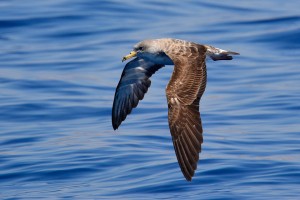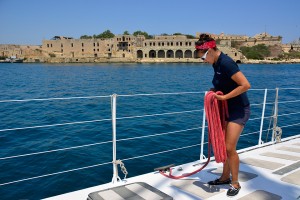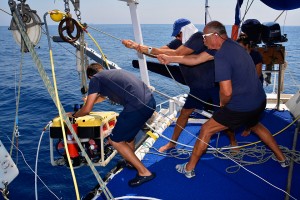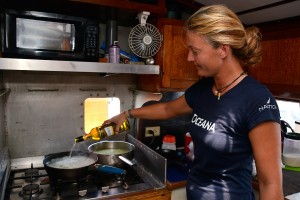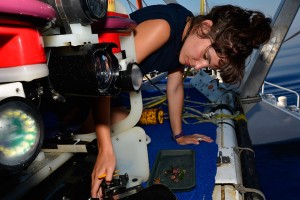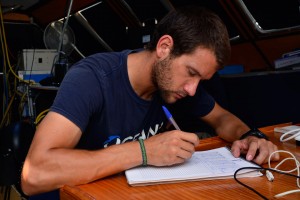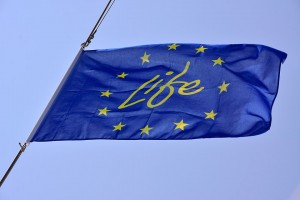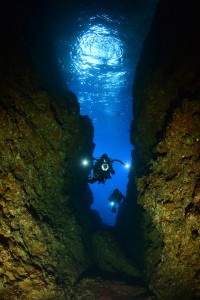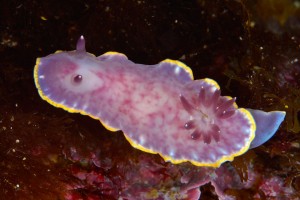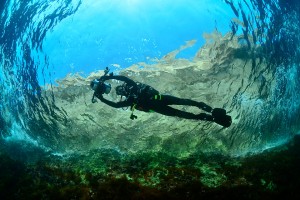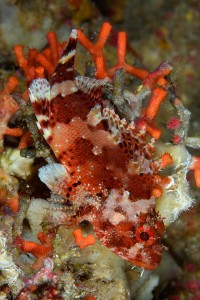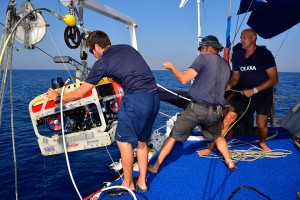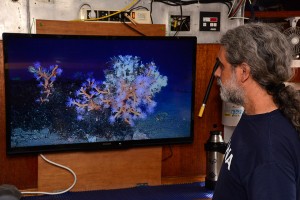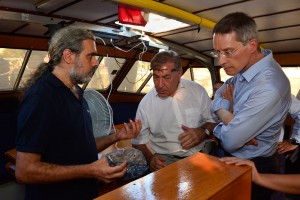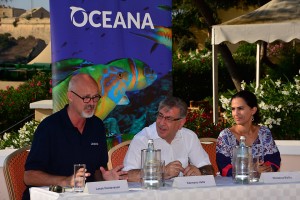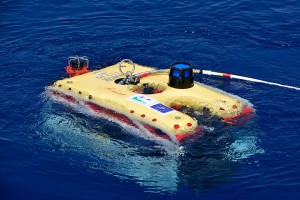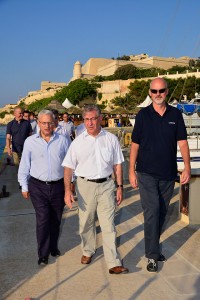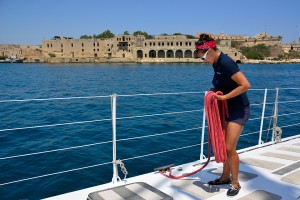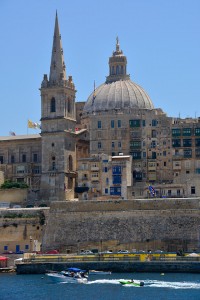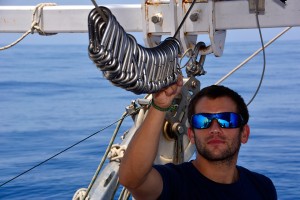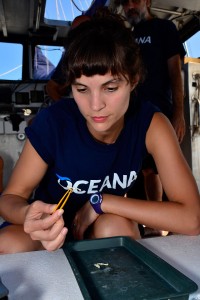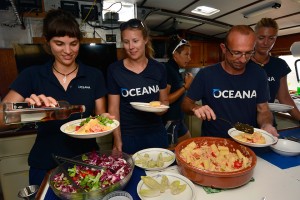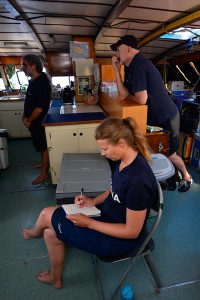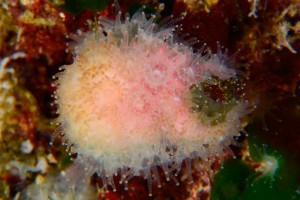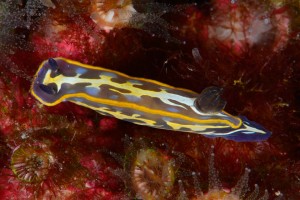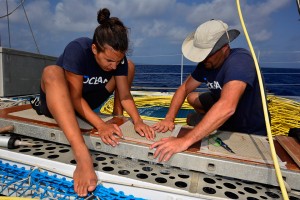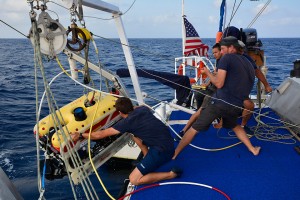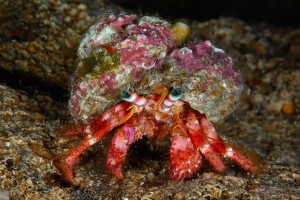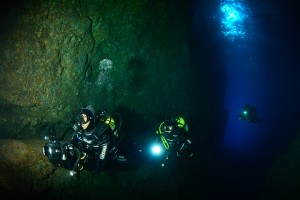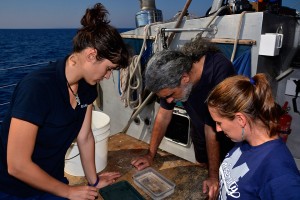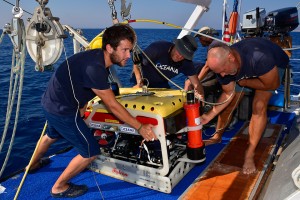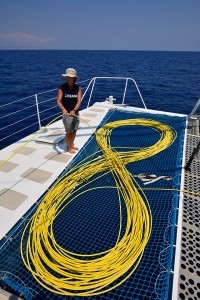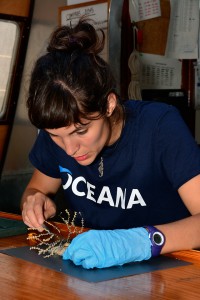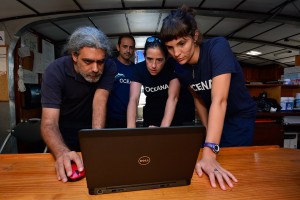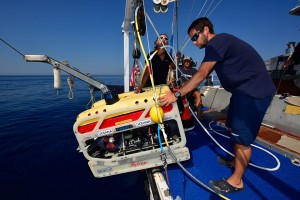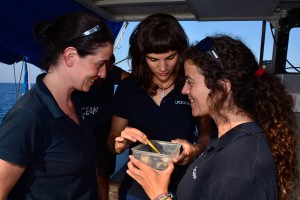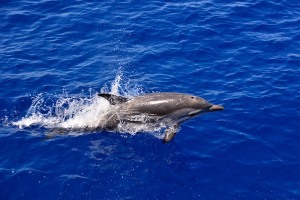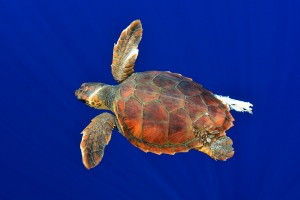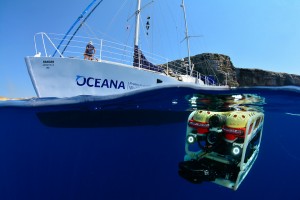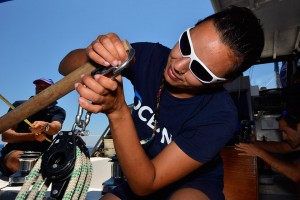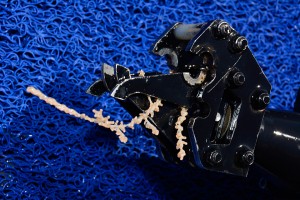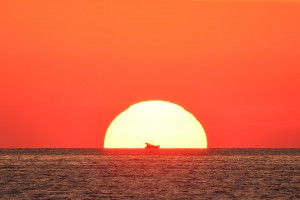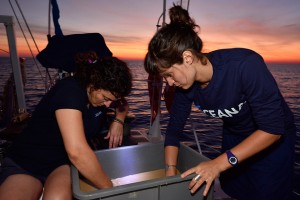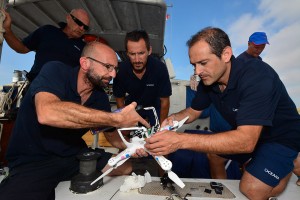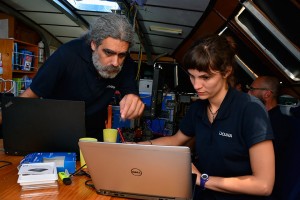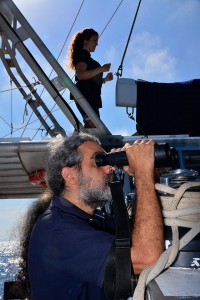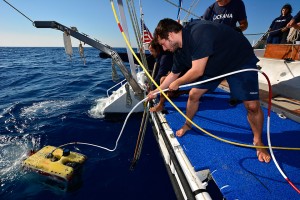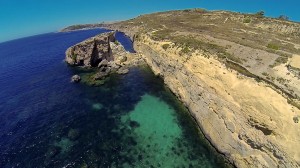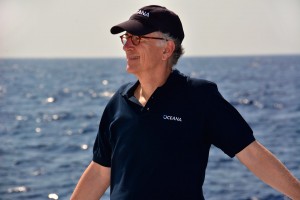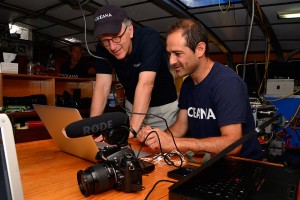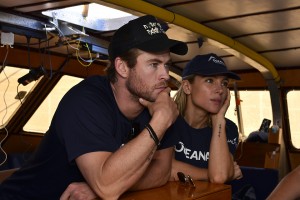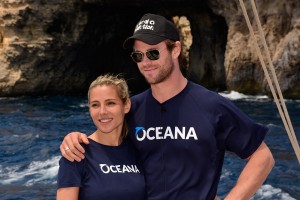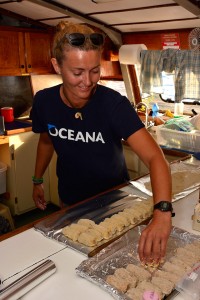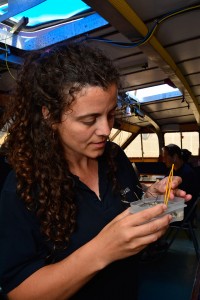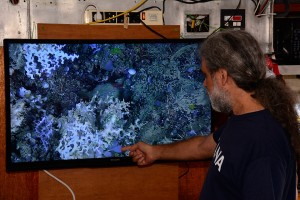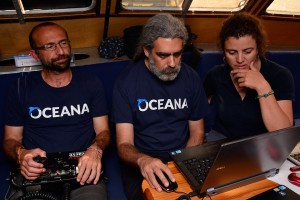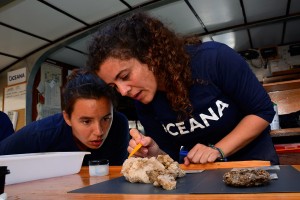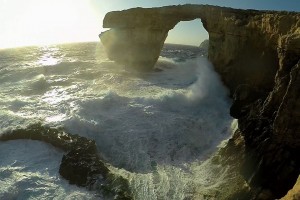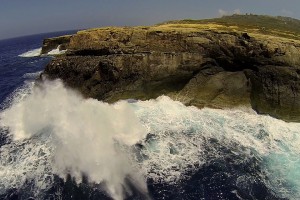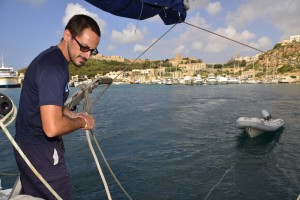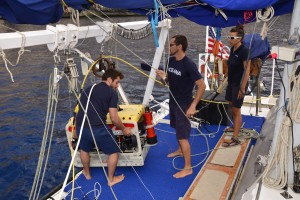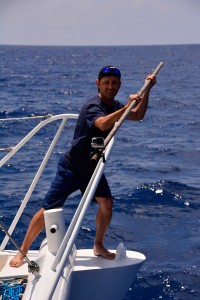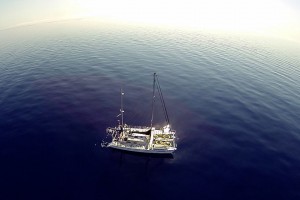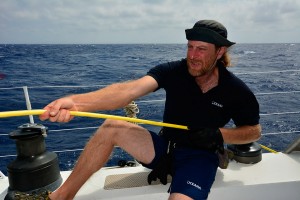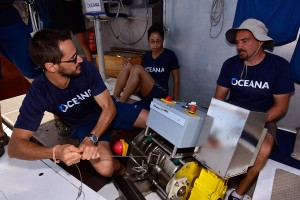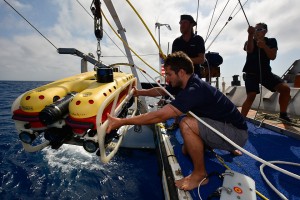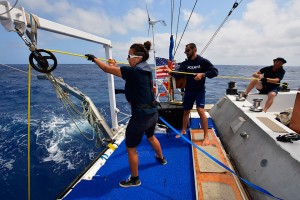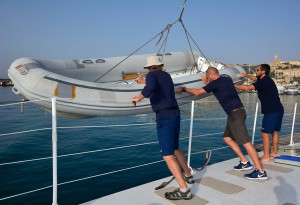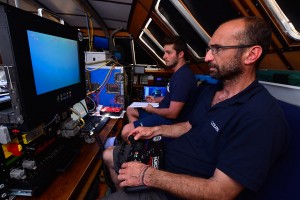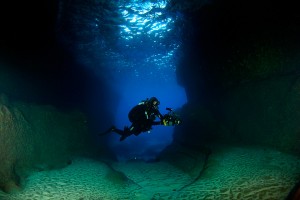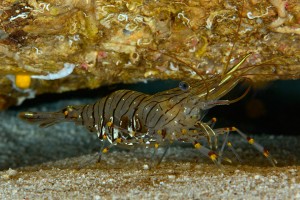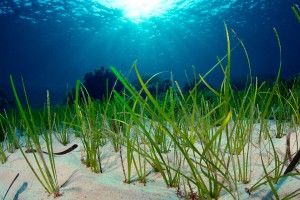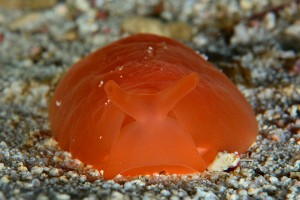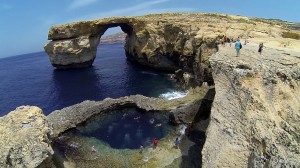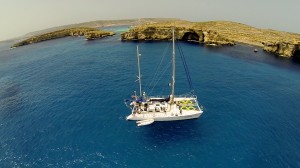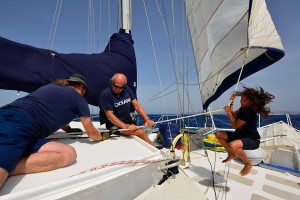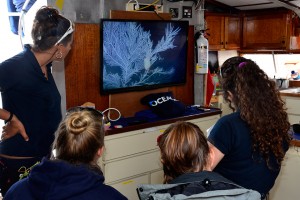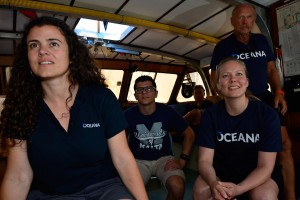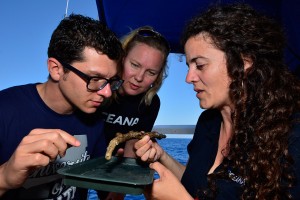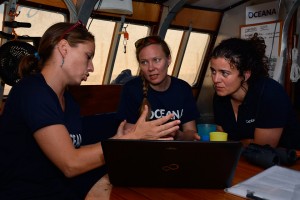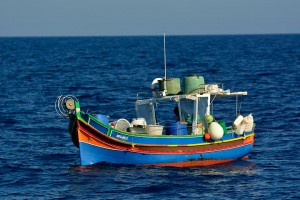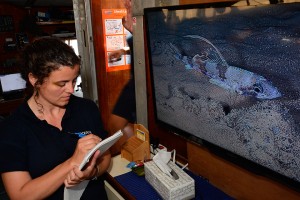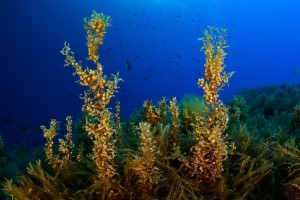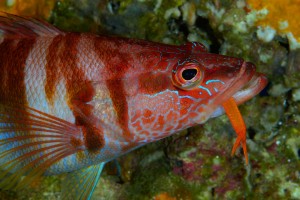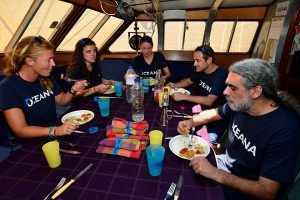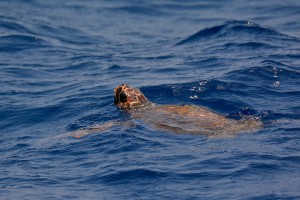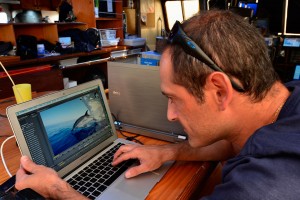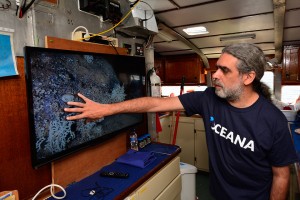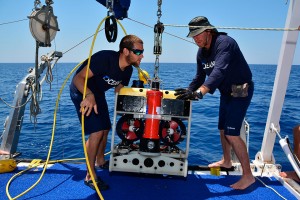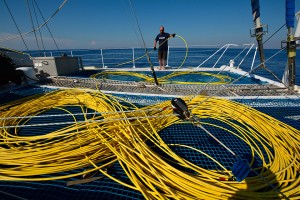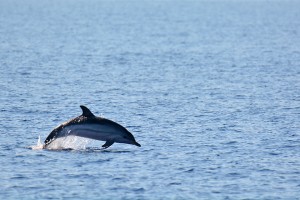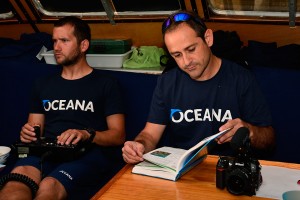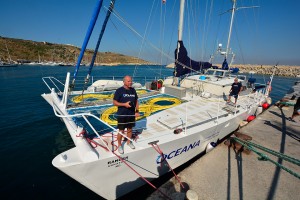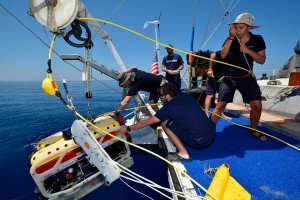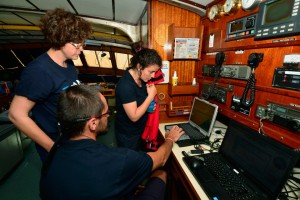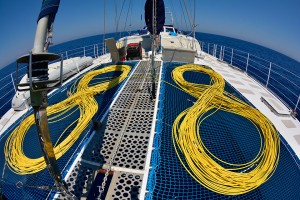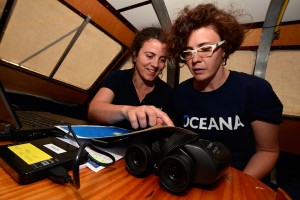July 22nd, 2015
Enrique Talledo
Thanks and looking forward to 2016!!
As the beautiful song of Karina (Spanish singer) says, “sometimes it´s good to look back” and this time, I am overcome by the desire of looking back and go through the many bottoms we have documented, the more than one hundred dives, about 4,000 nautical miles sailed and the one-of-a-kind moments when we found the weirdest creatures that seemed to come from Jules Verne´s most adventurous novel. Gone are the days of intense work, uncomfortable sailings and unbearable high temperatures, but we are pleased to have contributed through our work to a better understanding of our oceans and their need of protection.
I´d like to take advantage of this opportunity to congratulate the more than 30 people who have been working on the Oceana Ranger and to those who have not been aboard, but have helped to make possible this oceanic dream.
Now, looking to the horizon, we know our work is not finished yet, our cameras will keep capturing the beauty of this underwater world and through images we will announce how vulnerable our seas are.
July 21st, 2015
Helena Alvarez
Exciting ending
At only two days away from the end of this year´s campaign we´ve decided to take advantage of the short time left. The area 4 is very large and there is plenty to survey so we perform seven ROV dives. The temperatures peak and the fans spin at full speed. After 26 ROV dives in the area, the result shows the wide biodiversity that exists in the circalittoral strip of Eastern Malta, where maërl habitats alternate with mud, gravel and rubble. We´ve also documented areas with emerging boulderswith a variety of species. For the last ROV dive of the day we decided to survey a cave located at around 35 to 50 m deep, which was spotted during a previous dive. Since the current kept pushing us against the wall, we only got to see the cave´s entrance, but we marked it to return next year.
July 20th, 2015
Marie Louise Pace
Maërl and rhodoliths
Today, Oceana set sail to Area number 4 which is located in the South East of Malta. The journey from Mgarr Harbour to the first area that was surveyed (around 1 NM from the coastline) took roughly two and a half hours. The crew managed to complete the ROV survey in six different sites under the scorching sun. The main features in these surveyed sites were the rhodoliths grounds and maërl beds. More surveys will be performed in Area 4 in the coming days, so stay tuned for more!
July 19th, 2015
Jesús Molino
Six more caves!
One of the main objectives of this campaign is to find sea caves. At depths of up to 50 m surveys can be carried out by SCUBA diving; four divers document in videos and photographs everything that is found. After a two-hour sail we got to the first area to be surveyed today. Two safety divers and two cameramen got ready for the action. Safety divers bring along notebooks, sample containers and sometimes an extra camera in case it´s needed; we also take buoys and reels, as buoys are used whenever we find a cave, so we can easily spot the exact GPS location of the cave from the surface. The reels are used to delimit the cave´s area or as signals to find the way out when the caves are located at great depths. Today we found six caves after two dives.
July 18th, 2015
Helena Álvarez
Pleasant visit onboard
Today Ursula and Dominique Eichenberger from Drittes Foundation paid us the most pleasant visit, which came along with two interesting dives. The first survey was carried out in a not very deep area where we had previously found rhodoliths, but this time what we found was mud withemerging rocks. We could also see crinoid aggregations, sea pens and corals such as Dendrophyllia ramea, scorpionfish, lobsters and even a small-spotted catshark (Scyliorhinus canicula). On the second survey, conducted at greater depths and in a different area, we were lucky to find concentrations of corals, congers, silver roughies, and large aggregations of euphausid shrimps. Our day got to its end being greeted by a pod of dolphins, which we hadn´t seen for quite a long time now.
July 17th, 2015
Carlos Minguell
Distinguished visitors
Good news: today there was no mud at all! The bad news is that neither did we see rocks or corals or sharks (of any colour) nor any other type of marine animal. At least it was all for a good cause, since the Ranger stayed berthed to welcome some distinguished visitors: in the morning Ms. Teresa Catelani, EU Monitor for the European Commission, paid us a visit and in the afternoon it was Mr. Karmenu Vella, European Commissioner for the Environment, Maritime Affairs and Fisheries. It was a great opportunity for Lasse and Ricardo to explain how we work and show some of the images and samples gathered during the dives carried out so far during this campaign. Both seemed pretty interested and I´m positive when I say I really think they had a good impression of the work done by Oceana, so, mission accomplished!! Tomorrow we´re going for more mud!
July 16th, 2015
Cristina Urien
Eolo goes on holidays
Ham, cherry tomatoes and arugula Pizza recipe
20 min medium 14 servings
Ingredients:
Puff pastry (3) //sliced ham//arugula//cherry tomatoes – 3 boxes//2 endives//Spring onion//olive oil//salt and pepper//Parmesan cheese.
1. The day before we prepare the tomatoes on a tray with a great deal of olive oil, salt and pepper, then we put them into the oven for around 6 mins at 200º celsius. We save them in a hermetic tupper with the oil until the next day.
2. Bake the pastry placing it between a couple of baking paper sheets and putting some weight on it, so it does not shrink and/or lose shape. When ready, place the ham and the tomatoes from the day before and the spring onion, bake it all at 190º for one minute approx.
3. Take the pizza out of the oven and use the endives and arugula as decoration, pour some olive oil and finally add the Parmesan cheese all over it.
We got to area number 4 and put the ROV into the water; it is curious though, how you can get attached to a lifeless device that reaches the depths and shows us what we cannot see with our own eyes. So I like it and hate it at the same time, as it gets to have a swim when the weather is so unbearably hot here. It seems Eolo has gone on holidays, so an army of fans are buzzing around. So work goes on and I have to make the lunch (which will not be a “cocido Madrileño” –Madrilenian stew/Spanish chickpea stew- nor lentils)
Happy summer and fair winds
July 15th, 2015
Albert Ferrer
Learning
One day more with us, no-scientists, watching how the actual scientists work searching on the mud, sand and rocks to find “something” we might have ignored for sure, but that now we stop to watch because it has left them all in awe, so we understand “it” is what we were actually looking for. It is worth taking a moment and listen to all what our colleagues have to say about “it”, that way we get to learn day by day a little bit more about the ocean.
July 14th, 2015
Christina Abel
Mediterranean compared to the Baltic
New sea, new species and new habitats, but threats are common and easily recognizable. My week joining the Life Bahar Malta Expedition onboard the Oceana Ranger is almost done. It has been very exciting being sailing and conducting surveys on this beautiful catamaran. The biodiversity in the Mediterranean is far different from the Baltic´s, the region I normally work with. The habitats and species are all new to me, so I have been trying to listen and learn from Ricardo Aguilar and Helena Alvarez who are experts on the area. Besides the wide biodiversity, I have also seen some of the threats that jeopardize the Mediterranean like plastics floating on the sea surface and lots of fishing nets entangled around coral reefs, which unfortunately are part of everyday´s sailing and surveys. On the other hand, deep areas in the Mediterranean are not suffering from eutrophication and oxygen depletion, like in the Baltic; the habitats and species present on the depths, would have been dead zones in the Baltic Sea. Today, for instance, we filmed a small-spotted catshark (Scyliorhinus canicula) with the ROV at 500 meters depth.
July 10th, 2015
Gianni Brill
High winds and swell
Today, July 10th, Mother Nature halted some of our work, due to high winds and swell. Nevertheless, we performed some dives next to shore in a calmer area of Gozo. Today´s divers were Jesus, Helena, Kike and Minguell. Discoveries were slim, but the exercise went very smoothly, followed by an early return to port. As the forecast shows, tomorrow should be a better day. It is worth mentioning that Christina from the Danish camp has joined the Ranger today.
July 9th, 2015
Enrique Talledo
Our sea-guardians
Five weeks ago we began this at-sea campaign. Days pass by, immersed deep in the environments of the continental shelf and the dark slopes surrounding the islands of Malta. For several months, the graphic information obtained will be carefully analyzed to produce a detailed report. This is how Oceana contributes – providing important data that will later help to protect at least 10% of Malta´s coastal and marine areas by 2020.
Throughout today´s journey, a group of common dolphins (Delphinus delphis), came to greet us; they are, along with the bottlenose dolphins, our guardians in this punishing sea. Every evening, our eyes stare at the horizon, looking for healthy and oceans full of life, a dream and a challenge to work and fight for.
July 8th, 2015
Jesús Molino
Diving through the caves
The first immersion is made by the divers, and we document the caves to see what we can find. We are at the exact same spot as the last dive. This is a crack visible from the surface, a cut in the wall 200m deep that splits into two paths; during the last dive we explored the left path, now it is the right´s turn. We went over the wall for 1 hour and 41mins and found 4 caves between the surface and the first 25m deep, some of them very narrow. These days I dream of the excitement explorers from yore might have had, seeking what no one has seen before, or at least that is the feeling we all have when diving where no documents or information have yet been recorded. These three islands keep surprising us every time we go through a new area and what´s still to come .
July 7th, 2015
Helena Álvarez
Like a family
Jesus gets up really early to go running before we all start working at 7:30. Cris sometimes has a swim in the morning in a small cove nearby. Pisha drinks a cup of coffee for breakfast (with plenty of condensed milk). Kike hates onions. Tomas is a vegetarian. Yaiza just returned from the Caribbean and knows how to make macramé. Ramón studies English in his leisure time. Carlos hates jelly. When James was 28, he created a gold mining company in Africa, where he lived for 10 years. Albert is always hungry. The captain´s mother is Italian. Riki makes a superb impression of Donald Duck. Gradually, the routine and life on board makes us all get to know each other since inevitably, we spend many hours together. Our work produces an interaction filled with “sorry, coming”, “fetch me that stuff” or “dibs”. The work and rest space, the kitchen, the dining room, the library, the laboratory, the robotics area, etc. are all packed into the 21m long X 10m beam of the Ranger.
July 6th, 2015
Tomás Morate
Sharing some nautical terms
Since in these diaries we find nautical terms of certain complexity that may result in a lack of understanding from the readers about the events taking place during the expedition, and also driven by the conviction that telling various at-sea events in a “journal” could be an arduous task for both the author and the reader, I hereby, doomed by the monotonous fate, clarify some nautical terms for earthlings.
EARTHLING
Hominids that mainly live in static places away from anything that looks like a boat.
BOAT
Strange and incomprehensible object that glides on the waters and floats because that´s what Archimedes´s principle states.
CATAMARAN
Two vessels joined in parallel that pay as two boats when entering the port.
BOW
It is that spot on the vessel to which earthlings head as soon as they have the chance . Once there, they stare at the horizon and with great solemnity and raise their upper extremities like a Cory´s shearwater skimming over the waves, causing other colleagues (if any present) to take out their cameras and capture this long-awaited moment that could make Leonardo DiCaprio´s sweetheart in the Titanic green with envy . This behavior causes great expectation and the alarming question that arises, among those who are not used to this shocking ritual, as to whether they´re going to throw themselves to the big blue or will remain on board.
STERN
The place of the vessel where earthlings flee once a fateful wave washes over them, tearing them from their “Titanic-like” pose. This is the complete opposite to the Bow since earthlings return crestfallen, with no camera and soaked clothes.
STARBOARD
Right side of the boat as seen from DiCaprio´s girlfriend’s position.
PORT
The opposite side to the starboard.
PORSTBOARD
No such thing exists, but it might be real for those who haven´t learnt the previous two terms.
July 4th, 2015
Carlos Miguell
Pig and mud
Since the Ranger has an American flag and today is America´s Independence day, the campaign´s Director granted us the day off and a roasted suckling pig along with some “Rivera del Duero” wine. Ah, such a nice time we had… No, just kidding. I think today we have “eaten” more mud than in the whole month of June; two long immersions and only a couple of rocks greeted us. Maybe some living soul, I could not really tell as all in my head is full with mud. I know I said this happens and this is equally important to scientific research. But hey, at least one white shark could have suddenly appeared, just like that, since today it´s my turn to write the diary…
July 3rd, 2015
Jesús Molino
The unseen
Today is a quiet day, so I would like to speak of what is not seen, of what no pictures are taken or shown. It takes several months from both the Logistics and Science department to prepare the Ranger for an expedition like this. A lot of people work from the office making our every day on board possible; this is a significant support unnoticed by the media because the Ranger is that good-looking boy who gets all the attention, even admiration I dare say. Without that work and support, it´s unlikely we´d be here today. “Live your life going unnoticed, but that everyone longs your absence” I cannot recall the exact saying or whom this phrase belongs to, but I think it describes the work done behind the scenes.
July 2nd, 2015
Helena Álvarez
Turtle in trouble
Is it a turtle? Nope. A turtle in trouble! The ROV found a turtle at a depth of 8 meters with a sack caught on its fin. Somebody help! Poor little thing! An environmental expedition encounters a turtle that gives the impression of being ready for a sack race.
Jesús—in charge of logistics, captain and handyman—jumps off the boat only equipped with some scissors (and his clothes of course) and frees the turtle! He smiles back at us while posing in every imaginable way to all the cameras flashing at him. The turtle is safe and sound.
July 1st, 2015
James Derby
Adventures and misadventures of the RANGER
This is the 2nd day of our overnight research expedition. My watch starts early with the alarm going off at 02:00. A quick cup of joe (coffee) and away we go. Thomas had the watch before mine so he fills me in on his findings of the big fishing trawler two miles off our port bow, which quickly became our starboard bow, as we drift and slip and slide in the silence of the night.
The two-hour watch passes quickly as my eyes are wide open and the salty cinema plays out in real time. The hull creaking and a slight slap of the halyards on the mast are the only sounds in the thick and dewy air.
04:20 Ramone is next to watch and the nothingness turns into morning as the first sun rays pop up during his watch. A quick breakfast at 07:00 and off to our first way point 3 miles away. The day begins with the first drop of the ROV at 08:00 to a depth of 800 meters below the surface. The work day is long but the team is solid and time passes quickly as there is always another chore to ensure the safe return of the ROV to the vessel.
After the second drop of the ROV at 16:00 the shout from Pisha to raise the ROV is music to our ears as we secure all the equipment and head back to port. It took us four hours and dodging a fishing boat or two until we made it back to Mgarr harbor.
The wind howls at 25 knots but Jesus was able to back her in. Ricky came on deck into the cockpit to shake hands and thank the crew for a job well done. Tied up, electric and water hooked up, it´s time to celebrate with a drink at the local Pub.
June 30nd, 2015
Helena Álvarez
Where it all starts
It all starts here. The discovery of new species or not described to a certain area or depth range, the documentation of threats to marine life, or the seed for a new Marine Protected Area. It all starts by knowing what lies there, where it is and its conservation status. Today I joined Malta´s campaign to work documenting these bottoms, most of them unexplored until today. The lack of information often represents a problem when trying to apply the necessary protective measures and, therefore, this is the first and indispensable step to achieve significant goals. Today we sampled the furthest zone off the coast and will spend the night at sea. I´m willing to see what lies below.
June 29th, 2015
Yaiza Santana
An amphora in our way
Today the ROV only had one immersion as the following two days will be fully dedicated to sampling, so we have today´s afternoon for resting a bit while drifting across the sea. In today´s immersion which was in an area we have visited before, we found an amphora that who knows for how long it has been there or where it comes from. This break helped us to renew our spirits, so tomorrow we are well-rested. Quiet evenings like these are quite a treat we´re all thankful for!
June 28th, 2015
Ricardo Aguilar
Eyes wide open
Today we were amazed by the huge eyes of a small group of amphipods that came inside a sponge we collected. Our eyes looked pretty much like those of the amphipods, being wide open with amazement as we found so much life in the sampled bottoms along with many vulnerable ecosystems and species of interest. The dives are not disappointing us. On board, we review the tapes, photograph the samples and start discussions on the identification of the observed species, and on their distribution in the Mediterranean or even across the Atlantic. The variety of bottom types, including both rocky and detrital bottoms, provides a striking diversity that deserves keeping our eyes wide open.
June 27th, 2015
Enrique Talledo
Maltese winds
Yesterday was an intense day where our divers and underwater cameras had the opportunity to document interesting marine ecosystems. Despite that today was the ROV´s turn to get wet, we had to turn around due to the rough weather conditions, without being able to carry out the dives scheduled for today. Most of us took advantage to update our everyday work, leaving enough time to record aerial shots of a rugged coastline with crystal-clear waters.
June 26th, 2015
Gianni Brill
From the captain
Today the 26th of June was a special day. In addition to having Julian from the University of Malta, we had the Oceana’s CEO Andy Sharpless. We had a nice ROV dive, followed by a real nice dive by the Ranger crew which included Yaiza as a present for her 26th birthday. Andy has delivered a very nice report on Oceana’s status and achievements translated later by Ricardo, and so ended another successful day for the Ranger.
June 25th, 2015
Silvia Garcia
Onboard surprise
Well, now we can tell. Last Saturday (June 20th), we had a special visit. Some might have already seen it in the media outlets and most of you reading know what I mean. June 20 diary facts are true, but it is not the whole truth of what happened that day in the Ranger. First we had to officially release the news since we could not tell a word before the release. Taking advantage of the fact that today the waves are too high to sail, I hereby certify for the record that Elsa Pataky and Chris Hemsworth were onboard the Ranger. The truth is we were all a little nervous, not knowing quite well where to stand or how to act. The cameras of our videographer and photographer were on fire! And although we are used to having them around documenting almost everything we do, we knew that the images of that day would spread like wildfire in the media around the world. And so they did! We have to say that they both are from this very planet, and are made of flesh and blood; it was great to see their true interest in Oceana´s work, answering their questions and explaining how we operate. It was a pleasure to have them onboard, and we hope it´s not the last time!
June 24rd, 2015
Cristina Urién
Cooking and sailing
SALMOREJO
Difficulty – low
20 min 14 servings
Ingredients:
2kg tomatoes //350g dried bread // 200g olive oil //3 garlic cloves // a pinch of salt // Spanish ham// quail eggs or chicken eggs
1. Clean and mash the tomatoes, strain to remove the skin and seeds, mash again adding the bread, oil, garlic and salt.
2. Decorate with boiled eggs (chicken or quail), diced ham and olive oil droplets.
Beep, beep, beeeeeeeeeep!!!!!!!!
6: 15h: The alarm clock goes off, off to work then! It starts looking like breakfast time on the table while the roaring sounds of the Ranger begin, the first steps on deck can be heard, the crew is waking up …
7: 30h: We set sail! From the kitchen I see the transformation of the table that is now crowded with computers and a change in the topic of conversations
I open the fridge and pantries, and the ideas that were simmering the night before start boiling in my head, the festival begins! We have a vegetarian, an onions enemy and a roasted suckling pig lover, this is becoming complicated!
11: 00h: “Amaiketako” a little snack to keep them happy.
13: 00h: Food is ready !!!
ON AGAIN! Bon Apetit!
June 23nd, 2015
Tomás Morate
Just a moment
It only takes a quick glance at a given spot on the way to fully change the day in just a moment.
In Rabat (Gozo), we came across a wall with this phrase, or maybe it was a message in a bottle:
“We cannot change the wind but we can adjust the sails”
June 22nd, 2015
Silvia García.
Finally back at sea
The Mediterranean was finally calm enough to let us rummage through its depths. Two immersions looking for reefs were our treat for the day. Gozo´s surface is rather pretty, but there´s still way too much to find out on its bottoms. On the first immersion we found detritic muds on the bottom and many interesting species. The second one was more exciting, with new habitats we hadn´t documented before that are perfect candidates to be protected as a ‘Reef Habitat’ within the Red Natura 2000 network. We also collected some samples of sponges and gorgonians using the ROV. Some of these are impossible to identify just from a picture, necessitating sampling. In fact we are not sure which exact species they belong to, but we do have a name in mind for them. No dolphins today, but there´s a nice day full of work behind us.
June 21st, 2015
Carlos Minguell.
Sea from land
As the weather forecast was hovering between awful and worse, our campaign director decided not to sail today as working conditions were too rough. So we took advantage of our day off as people normally do: oversleeping, enjoying a quiet breakfast and doing some sightseeing. We visited the northern part of the island were the waves were breaking violently; luckily we stayed inshore today.
June 20th, 2015
Silvia García.
Windy Saturday
We are almost at the limit of the wind speed we can work with. We tried to work in a sheltered area, next to a cape at the south of Gozo. We could feel the wind speed as it was moving the boat at about 0.7 knots, which was not ideal. When using the ROV to carry out the transects to document the bottom, and to stop at the most interesting areas, the wind speed is ideally lower than 0.3 or 0.4 knots. We spent an hour with the ROV in this coastal area and found some rocks and sandy bottoms at about 100m deep. We set off back to the harbor, as the wind started blowing really hard, so there was nothing else we could do apart from finding shelter and waiting until the wind died down.
June 19th, 2015
Enrique Talledo.
After the storm comes the calm
It was seven in the morning when we started what would become a good day for everyone. A new working day awaited us with the uncertainty of not knowing if sea conditions would let us send the ROV down to a significant depth. But we got lucky and could document interesting detrital mud bottoms with rocky outcrops.
After several immersion hours in the deep bottoms off the island, we went back to the harbor quite satisfied with the work done. On our way back, the ocean greeted us once again with an endearing gift: a dozen bottlenose dolphins (Tursiops truncatus) that delighted us with their presence at the bow of our boat.
June 18th, 2015
Brais Lorenzo.
Puppy
It allows us to see fantastic things in areas no man has visited before. It brings small gifts from the seabed, so we can learn a bit more about the waters that surround us. Because no matter how far away it is, it always obeys our instructions. And although it has no feelings, we always want it back on board every time we deploy it into the water. Because it’s a crew member. For the ROV.
June 17th, 2015
Jesus Molino.
High tide and an entangled propeller
When we reached the ROV immersion spot, the wind increased slightly. The ROV was about 780m deep, so as the wind was blowing harder and the waves came before expected, we suspended the immersion and began to lift the ROV back to the surface with no major problems. Our journey turned complicated as the waves were too big. Shortly after leaving the port, we came across a fishing gear. The buoys are usually plastic bottles hard to identify, and the wind blows hard enough to tauten the ropes leaving them on the surface. As a result, even bringing the starboard engine to a stop, both buoys got entangled in the propeller. We had no choice but to jump into the water (Jose Manuel and I) and set if free ourselves to keep on going; if we had done otherwise it could have gotten into the propeller shaft and caused a leak.
June 16th, 2015
Yaiza Santana
Every day´s reality: plastics
Yes, the depths of the oceans and the life they hold are simply breath taking; dolphins, turtles and all the marine life that captivates us. We see many beautiful things but sadly they are never alone: there´s also pollution, plastic bags, cans, boxes and ropes in EVERY immersion we carry out, but they´re also present on the surface. Up to 1000 meters deep we ALWAYS find plastics and fishing lines even trawl lines and all kinds of waste. If we do not develop a proper model of production and waste management, the life we see today will soon be gone. We need to raise awareness, it´s important that everybody knows that plastics at sea are seen every single day.
June 15th, 2015
Silvia Garcia
Malta´s walls are dangerous
We saw it coming, and eventually it happened. Today we were about to lose the ROV; it was a rather nail-biting situation, the umbilical cable and the ballast were hooked on everywhere. The ROV itself was trapped with little mobility under a rocky ledge of the walls of the bottoms we are investigating. But we managed to get everything back onboard, so we can say we´ve been lucky. I just don´t think the ROV, that ended up with a broken arm because of the efforts to free itself, feels the same way though.
June 14th, 2015
Enrique Talledo
The quest for caverns and underwater caves (Comino Island)
After the storm that hit the island yesterday, we set off determined to carry out two dives in Comino Island sheltered from the swell.
Our goal, to document two ecosystems included in the Habitats Directive: sandbanks and underwater caves. Our day finished with dozens of images of species that will contribute to improving the protection of these Mediterranean submerged paradises.
June 13th, 2015
Silvia García
Well-deserved break
Today we did (in my opinion) what one must do while in Gozo: enjoy the sea and the landscape. The wind was blowing too hard to go out sailing, so, after so many days of non-stop hard work, the moment for a windy day off in Gozo finally came. As a respectable bunch of tourists, we rented a 4×4 convertible and set off to the famous Blue Hole. It was simply astonishing, and the water temperature was just perfect to cope with the Mediterranean hot temperature in the island. During the afternoon we visited the impressive cliffs at the south of Gozo, that are even more dangerous with the wind blowing that hard, I reckon, but still an incredible sight to witness. It was a well-deserved break.
June 12th, 2015
Gianni Brill
Close to the wind
It was an early morning for some of us on Friday the 12th of June. Departure was scheduled at 06:00 am. We arrived at the site of our daily research location and lowered the ROV. Some long hours of research led to the ever awaited moment of “return to base” call. As wind was favorable, the crew and I hoisted sails. To my disappointment and reconfirmation, although they make great work platforms, sailing catamarans close to the wind is not very efficient. Shortly we abandoned the idea and motored back to port.
June 11th, 2015
Hanna Paulomaki
As exciting as expected
When I was asked by our Science Director Ricardo Aguilar last winter if I wanted to join on-board the Ranger for Oceana´s Malta expedition it was very difficult not to sound overly excited (which I probably did) when saying yes. Because I REALLY wanted to go on-board the Ranger. And, here I am! Finally! Sailing and doing field work for the second day now. And, I have to say, it is as exciting as I thought it would be. Though the ROVs we have done so far may not have been the most exciting ones, as they have been carried out in relatively deeper waters, today we managed to spot some very nice marine features, like plenty of bamboo corals with lobsters and other types of marine life. With all the information collected so far, I hope we are able to provide important insight into the marine ecosystems in Malta’s waters and fill in data gaps to enhance better marine protection and management.
Another meaningful part of the work is to detail the bathymetry data available. As also found out during Oceana´s earlier expeditions, the official charts are able to give only rough estimates of the bottom formation and having more accurate data on this helps in drawing a more realistic picture of the world found beneath the waves. Today for instance, we found out that something that looked like a seamount in the charts actually appeared to be a pit.
The days at sea may be long, but they are totally saved by the things we get to find and the groups of dolphins that come and put on a show for us when we least expect it.
June 10th, 2015
Yaiza Santana
Unexpected visitors
Today was a day full of mud, vast plains, and more mud. Days like these are quiet for sailors, as they do not have to frantically lift up the umbilical cable before the imminent encounter with a 100-meter wall. That lets us spend the breaks quietly and observe what the robot sees. Today, our immersion was welcomed by a nice and rare squid, whose large eyes reflected the ROV, what an incredible picture! Back to the harbor and to celebrate Hanna Paulomaki´s incorporation to the campaign, five bottlenose dolphins danced around our vessels´ bow for quite a long time, showing us their bellies and backs. Today, while talking with Tomás, he made us reflect on how lucky we are to be part of this expedition. Perhaps no one has ever seen this part of the deep-sea before…
June 9th, 2015
Tomás Morate
Treasure onboard
Work is hard but we know there´ll be an immense payoff
Hidden beneath the giant´s unpredictable skin and guarded by Neptune himself.
Protected by unfathomable chains and kept in a silver glitter trunk and smells of the sea.
Keep going crew!! The reward is shared on the Ranger´s deck when the sun sets in Gozo Island.
June 8th, 2015
Silvia García
Looking for caves
The Habitats Directive lists a number of marine habitats present in European waters, identified as being of “Community interest”. These are: shallow sand banks, seagrass meadows, reefs, underwater caves and several formations originated by gas emissions. Member States are required by this Directive to determine the presence of these habitats in their waters and protect them. In Malta, under the LIFE + BAHAR for N2K project, we will work on three of them: reefs, sandbanks and caves. Today, after a week carrying out our at-sea expedition looking for reefs in the deepest areas, we stayed closer to the coast looking for caves. Thanks to our divers and the ROV, we surveyed a good stretch of the southwest coast of Malta, between 0 and 40 meters deep, looking for underwater caves. Despite the walls of this part of the coast being extremely vertical, both above and below the sea surface, many species of Mediterranean fauna can be found along their various cavities and ridges, as our divers documented. We haven´t found any caves yet, but it is our first day dedicated to this habitat and there are still many stretches of coast to investigate and many days of our campaign. We´ll keep looking!
June 7th, 2015
Scarcity counts
Carlos Minguell
Last night FC Barcelona won the Champions league. That is the only interesting event I can recall from the last 24 hours that hasn’t been as exciting as I would have expected. Still, the ROV went over more than one kilometer – at depths of 954m -this might appear easy, but it is actually tough work to go through. But days like these come along: tons of mud, a lot of stones and barely an animal to spot. It is not exactly “fun”, but as our scientists wisely say: “Science moves forward this way, it is as important to find an area full of life as it is to confirm its scarcity somewhere else”. Everything is pretty useful data since it helps us understand marine ecosystems in such a way that we can later determine how it must be protected. I agree, but if I got to choose, I´d rather have one of the “other” days awaiting tomorrow.
June 6th, 2015
Ballast entangled
Jesus Molino
At 7:00 am, the crew starts appearing on deck; by 7:30 we are ready to throw the lines and leave the harbour. We head northwest, surrounding the island near its cliffs. Half an hour later, everything is ready to put the ROV into the water. The first dive is carried out without too much trouble, some wind and some rain at the beginning, but nothing to worry about. Nonetheless, things become a bit complicated right after collecting a sample in the second dive. The ballast that holds the ROV´s umbilical cable must have gotten entangled with a rock. When this happens, the ballast and the cable must be lifted manually, (around 100kg at 400m deep). Fortunately everybody came out to help and we finally got to put everything back on deck, and even the sample taken is safe and sound. We had to repair the cable and replace the ballast on our way back. Now, at 19:30, twelve hours after leaving the harbor, we are still an hour away to moor the Ranger, tomorrow will be a new day …
June 5th, 2015
Sailing with dolphins
Albert Ferrer
Right after breakfast, the Ranger engines begin to roar, indicating we are heading to a new spot; dolphins make a great morning company until we finally got to the point of immersion (in the channel´s area). Once our vessel´s gear stops, each crew member takes their position to launch the ROV into the water: checking the pole, taking care of the umbilical cable, confirming the system works, recording and confirming we are in the right spot. Once every operation is checked, the ROV is launched into the water; the descent begins and with it comes the surprise of discovering what we have under the hull at great depths: corals, sponges, stones, fish, squids, sharks, and unfortunately several fishing gears and litter. After two dives in the area, we head back to the harbour. But today’s work is not finished, we have to analyze all the data gathered, perform maintenance on the ROV and the boat so that we are prepared for the next day.
June 4th, 2015
Opening the eyes of the world
Johnny Balch
Hello, and welcome to the diaries of an expedition by Oceana. I will try and give everyone a picture of what it is like to be part of such an exciting adventure. My part in this expedition is a small, but I would like to think important, part. I will be the engineer/first mate aboard this 71 ft. catamaran. Maintaining, repairing, and sailing this boat will be my priorities.
Myself, I have raised two beautiful daughters and have two grandchildren in California, always near the beaches. And ALL of us love the oceans. I am happy to be a part of opening the eyes of the world, to the importance of conservation, management, and further discovery of OUR MOTHER OCEAN. We all must play a role in preserving today’s treasures for our children´s children!
June 3rd, 2015
There is life in the mud
Yaiza Santana
Hello!
My name’s Yaiza and I’m working as a marine scientist on the Oceana Ranger. My main roles on the boat are to support navigation and repairs, particularly the manoeuvres with the ROV. We’ve moored in Sagunto, Valencia, passing through Burriana and Barcelona, before venturing towards the Menorca channel and arriving in Tunisia four days later. The navigations went really well and, although some days the weather was rough, by reefing the sails and keeping a close watch on the weather we were able to ride out the storm without too many problems. We’re currently in Gozo, where we’ll be spending two months. For the moment we’ve only observed the muddy ecosystems, but the life we’ve been able to see in those depths never ceases to amaze me. We’ll keep you updated, but for now we’re heading back to port after a mellow day’s work on a calm sea.
June 2nd, 2015
Second day of the expedition
Silvia García
It’s almost 9:00 p.m. and we’re back at port. Today we completed two dives with the ROV in one of the areas identified for research during the oceanography expeditions included in the LIFE + BAHAR for N2K project. This area is located to the north of the island of Gozo, about an hour’s sail away, and we worked at depths between 300 and 500 metres. Perfect weather for this type of work, given the difficulties that having a robot in the water implies; it’s impossible if the waves are too high or the current too strong. However, we can tell that the heat, already a strong presence, is going to be a constant companion. To top off the day, several sightings of merchant ships, longliners and trawlers around us and, on the journey back to port, a manta ray jumping out of the water, a sunfish and, at our bow, four bottlenose dolphins who came to welcome us to Malta.
June 1st, 2015
Ranger’s 2015 campaign in the Mediterranean Sea begins
Ilaria Vielmini
Today the Ranger’s 2015 campaign in the Mediterranean Sea begins. It is a two-month campaign mapping the underwater world surrounding Malta in the heart of the Mediterranean Sea. I’m sure there will be unexpected discoveries; amazing images and videos of marine life; laughter with the crew; and magical encounters with cetaceans at sea. However, this is not about the experiences. It’s an important research project and today is its first day. It’s the day when you realize you can make a difference. I’m going to be contributing to the exploration of a previously unknown world; a world inextricably connected to humanity despite being largely unseen and undocumented.
The excitement is building. It’s l0:00 and we have just arrived at the submerged Maltese Bank, 23nm north of the Island of Malta. The sea is calm, the sky is blue and the seagulls are circling inquisitively as we manoeuvre the Ranger into position. So, here we are, ready to start. 10:45, the Remotely Operated Vehicle (ROV) is in the water: the research has now officially begun. I’m at the stern of the boat watching the ROV disappearing below 200m and think to myself: I’m at the forefront of a new chapter in the understanding of the Mediterranean Sea.



